Ong Nui Temple
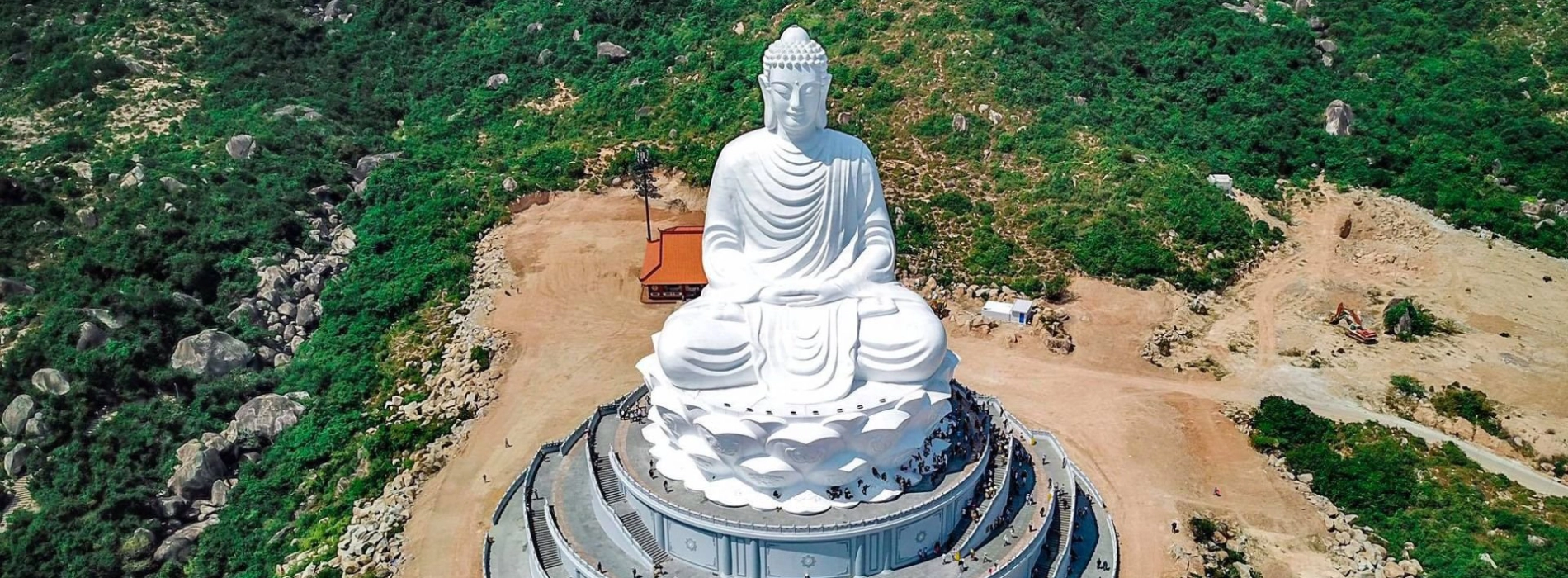
On a quiet ridge in central Vietnam, perched above crashing waves and ancient land, stands Ong Nui Temple. Not merely a place of prayer, but a sanctuary where silence speaks louder than words. There are many sacred sites scattered across the country, but this one? It doesn’t just impress. It transforms.
At the heart of it all is the Giant Buddha statue in Quy Nhon, watching over Thi Nai Bay like a gentle giant. The wind carries the scent of incense. The sun filters through dragon-shaped rooftops. The air? It doesn’t just fill your lungs. It calms your mind.
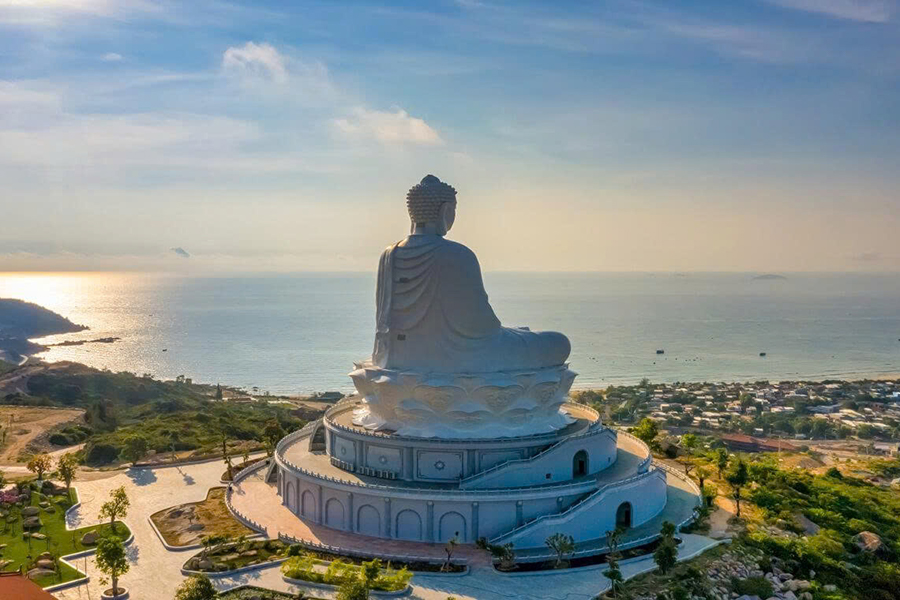
Seated Buddha statue at Ong Nui Temple. Source: fleurdelys hospitality
Ong Nui Temple, also known as Linh Phong Pagoda, was founded in the 18th century by a Zen monk named Le Ban. Locals respectfully called him “Ong Nui,” meaning “the Mountain Elder.” He spent years meditating in the caves of Linh Phong Mountain, eventually attracting followers who helped build the first shrine.
During difficult times, the temple also served as shelter for villagers and scholars. Some came to escape war, others to escape their own troubles. What remains today is a place shaped by generations of quiet seeking.
Read more: Center Vietnam Tour 4 days 3 Nights: Center Discovery
The temple is perched on Linh Phong Mountain, in Cat Tien Commune, Phu Cat District – about 25 kilometers northeast of Quy Nhon city. Though not far from the coast, it feels worlds away once you’re there. The view of Thi Nai Bay stretches wide, while the sea breeze cools the steep paths that lead up the hill.
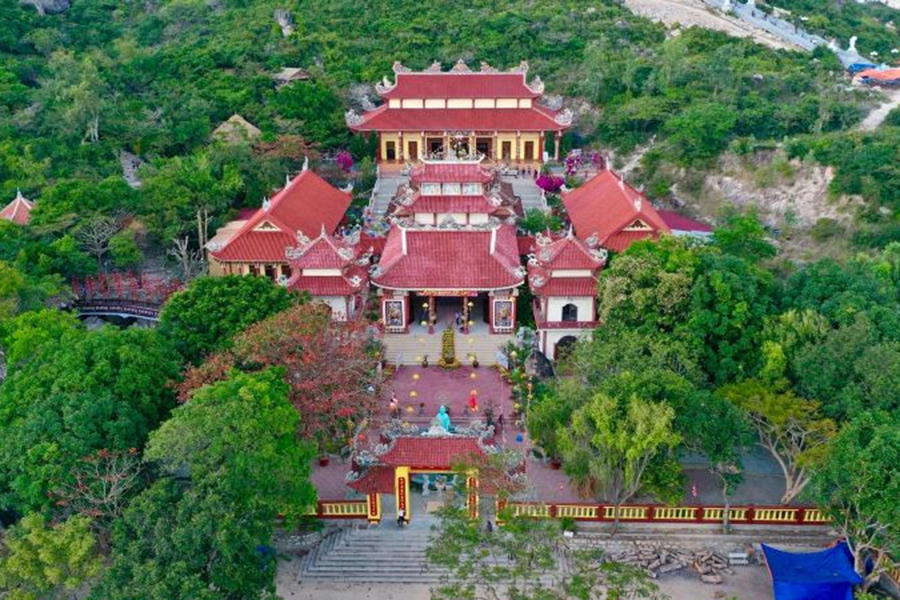
Aerial view of Ong Nui Temple nestled in the mountains. Source: datviettour
Travelers usually start from Quy Nhon. From the city, you take National Highway 1A heading north. After about 20 minutes, signs will direct you toward Linh Phong Mountain. The final leg of the journey includes a winding mountain road, and eventually a staircase with over 600 stone steps.
Motorbikes or taxis can take you to the base. If you’re unfamiliar with the area, joining a local tour is a good idea. not just for convenience, but also for the local stories shared along the way.
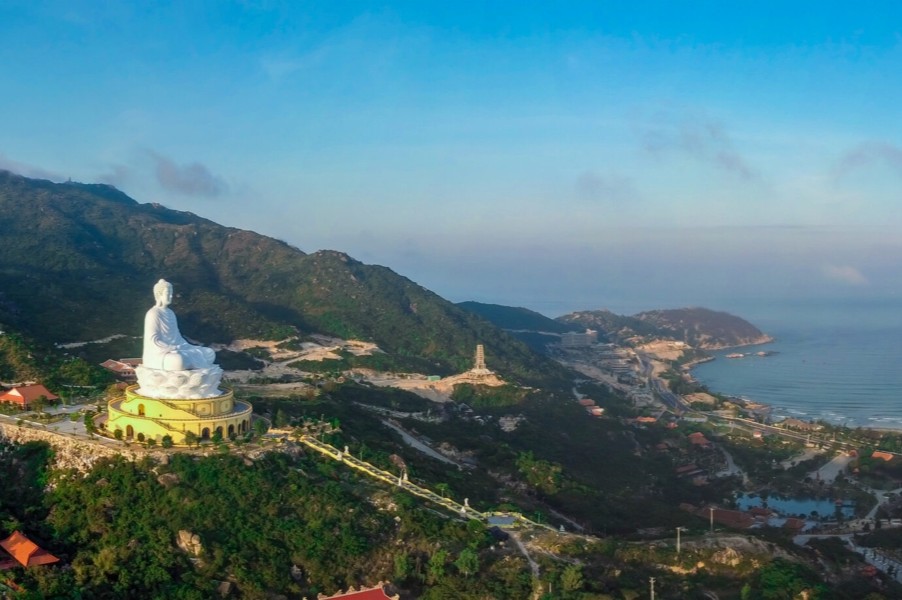
Panoramic view of the Great Buddha statue overlooking the Quy Nhon coastline. Source: vinwonders
Discover the Temple’s Unique Architecture
The temple doesn’t try to dominate the mountain. Instead, it follows the land. Walkways curve around boulders, and buildings step down along the slope like they’ve always been there. Roofs are tiled with traditional dragon designs. Lanterns line the paths, but everything is simple. Nothing is overdone. Here, the beauty lies in restraint, a core principle in Vietnamese Zen tradition.
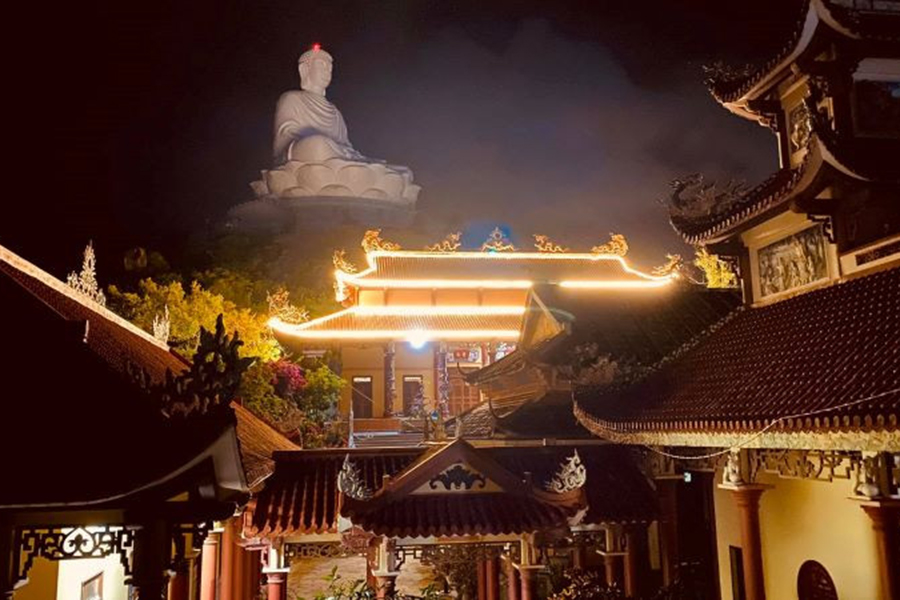
Ong Nui Temple at night. Source: vinwonders
See the Giant Buddha Statue
At 69 meters high, the seated Buddha statue is one of the tallest in Southeast Asia. But its impact goes beyond size. Sitting cross-legged and facing Thi Nai Bay, the statue reflects stillness. From some angles, it seems to watch over the sea and the city beyond.
Built in white granite and completed in 2017, the statue serves as both a spiritual symbol and a local landmark. On clear days, it can be seen from parts of Quy Nhon city.
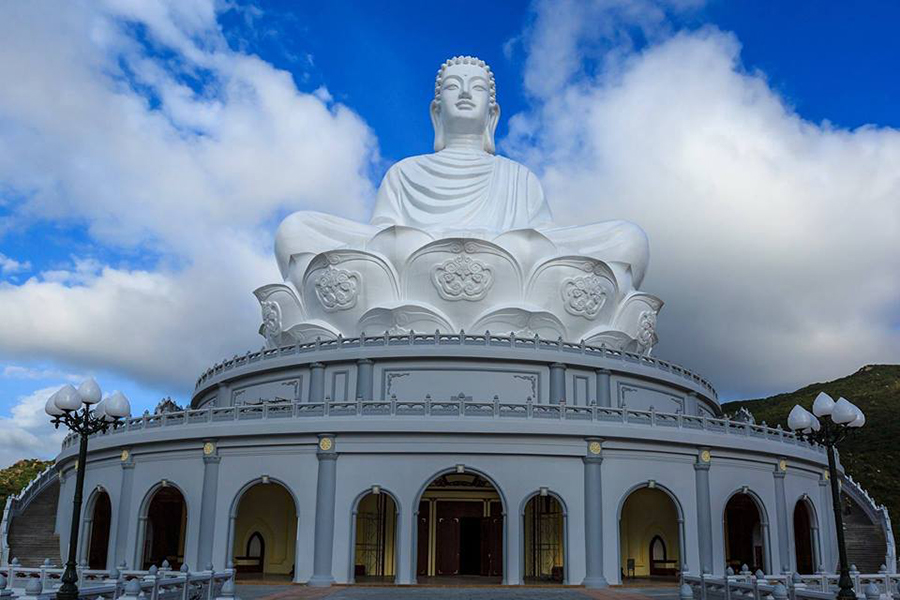
Front view of the giant white Buddha statue at Ong Nui Temple. Source: vinwonders
Join the Annual Festival
Every year, on the 24th and 25th of the first lunar month, the temple hosts a quiet ceremony to honor a revered monk, Zen Master Thich Trung Tinh. Visitors come not for entertainment, but to pay respect, offering fruit, lighting incense, and sitting together in silent reflection.
There are no loud parades or lantern shows. Instead, the atmosphere is peaceful. Monks serve free vegetarian meals, and the community gathers in simple faith. It’s a ceremony rooted in practice, not performance.
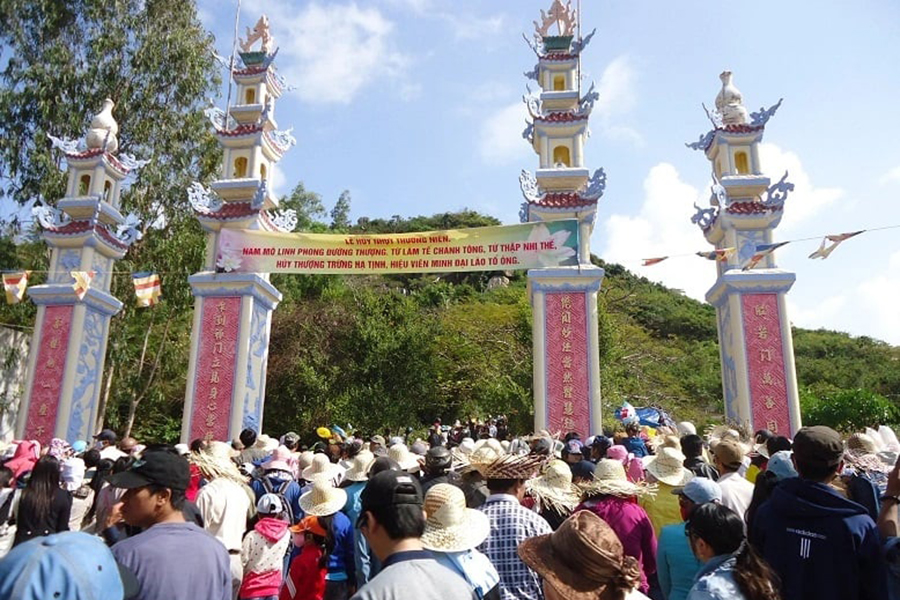
Main gate of Ong Nui Temple during a festive pilgrimage. Source: vinwonders
Enjoy the View of Thi Nai Bay
From the temple’s highest terrace, Thi Nai Bay stretches out like a painting. The fishing boats, the soft curve of the coastline, and the sea meeting the sky — it’s a view that lingers.
Sunrise brings soft light over the waves. Sunset paints everything gold. People stand there longer than they plan to, just watching. No one rushes.
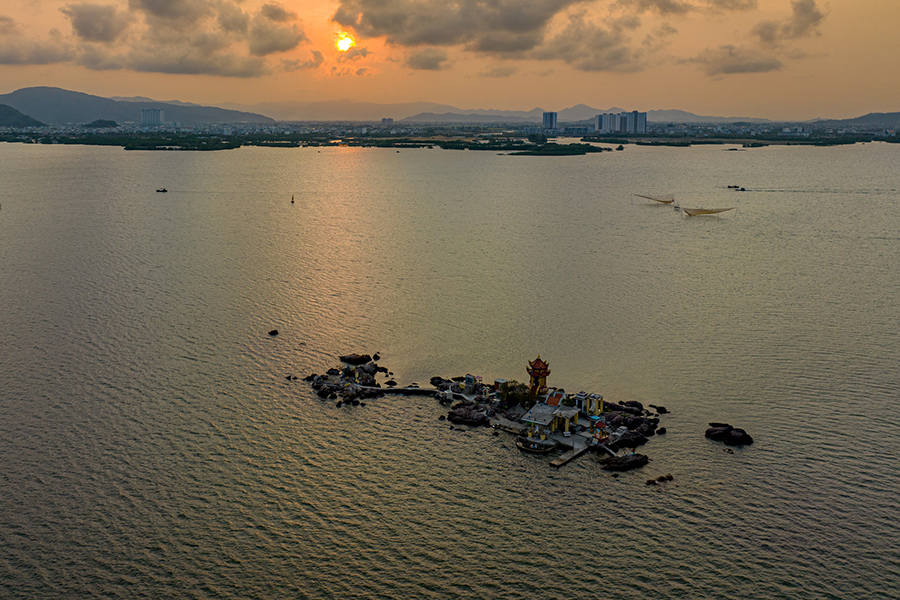
Sunset over Thi Nai Lagoon with a small shrine on rocky islet. Source: DŨNG NHÂN
Visit To Cave (Hang To)
Above the main complex, carved into the mountain, lies To Cave. This natural rock chamber once served as a meditation space for monks. Inside, it’s cool and quiet. A few simple altars stand beneath low ceilings of stone.
To reach the cave, you follow a narrow path up through trees and rocks. It’s not a long walk, but it’s steep. The reward is solitude, a kind of stillness you can’t find in the city. Many say this is where they feel the temple’s true heart.
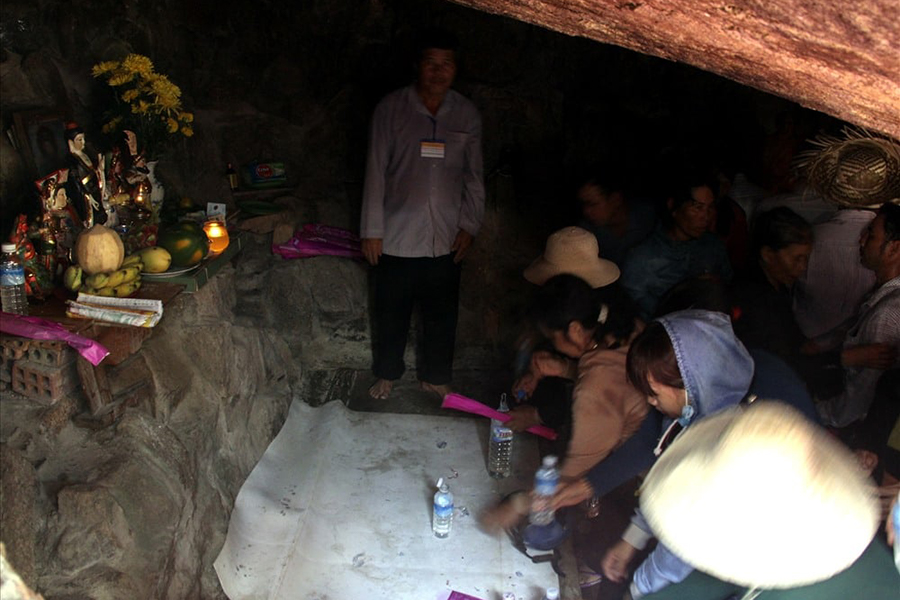
Inside the TO cave where Zen master Ong Nui once practiced. Source: vinwonders
Explore Nearby
The area around Ong Nui Temple is worth a full day. On your way back to Quy Nhon, you can stop by Thi Nai Bridge, explore quiet beaches like Ky Co or Bai Xep, or enjoy fresh seafood in Nhon Ly fishing village. These spots offer more than pretty views, they tell the story of coastal life in Binh Dinh.
And maybe… leave your phone in your bag for a while. Some experiences can’t be filtered.
Ong Nui Temple isn’t for those seeking thrills. It’s for those looking to breathe slower, walk quieter, and feel deeper. Whether you come for the architecture, the festival, or simply to stand before the Giant Buddha and take in the sea view, this temple has a way of changing your pace. And sometimes, that’s exactly what a journey should do